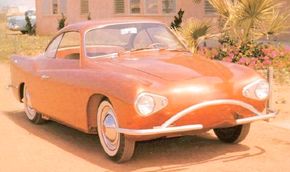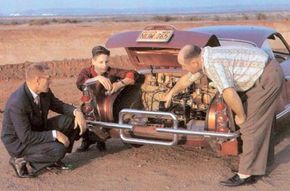The 1959 Charles Townabout concept car was an electric automobile that turned out to be better in concept -- no pun intended -- than in reality. Car buyers weren't quite ready to shell out the manufacturer's asking price for a small car, and technology wasn't advanced enough to work out the Townabout's quirks.
Electric cars have long been big news in air-polluted California, where lawmakers told automakers to sell 40,000 "zero-emissions" vehicles starting in 1998 and some 200,000 by 2003. It was rather draconian edict evidently inspired by the movie Field of Dreams: If you tell them to build electric cars, they will, never mind the cost, technical problems, and other unresolved matters.
Advertisement
Of course, in addition to being the smog capital of the world, Southern California has never been a hotbed of automotive invention, so it is no real surprise that various vocal locals tried sparking public interest in "volts wagons" long before legislators did.
San Diego, for example, was home to one very practical electric car way back in 1959 -- the Charles Townabout concept car. Just as interesting, the Townabout originated in the region's second best-known industry after filmmaking, the then-booming aircraft field.
Even its name had the quaintly memorable quality of a movieland character: Charles Townabout. Townabout also suggested the car's intended driving role.
The first part of that name honored Dr. Charles Graves, executive vice-president at Stinson Aircraft Tool & Engineering Corporation, the postwar descendant of the famed Stinson Aircraft Company. He assisted Dean Van Noy with engineering chores, but he was not your average corporate bigwig.
Besides being a dentist, Graves had credentials as both physicist and electronics engineer. As such, he took due note of recent predictions that "super" storage batteries were just around the corner, followed soon perhaps by fuel cells that could make electricity by means other than combustion.
Graves was also aware of electric-car experiments going on at places like the Cleveland Vehicle Company in Ohio and, closer to home, the Pioneer concept car at the Nic-L-Silver Battery Company up in Santa Ana, California.
With the right technology and a little luck, he reasoned, Stinson might just beat everyone else to what loomed as a huge and lucrative new market for electric cars that could carry the firm through the ups and downs of its aircraft business. Accordingly, Graves put Dean Van Noy in charge of engineering an amps-powered auto, assisted by Dick Bardsley and Graves himself.
Go to the next page to find out what this team came up with.
For more on concept cars and the production models they forecast, check out:
- Concept Cars
- Future Cars
- Consumer Guide auto show reports
- Classic Cars
Advertisement





